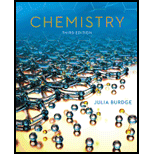
Concept explainers
Interpretation:
The greatest ionic character, smallest ionic radius, greatest ionization energy, and the most acidic oxide among the given species areto be determined.
Concept introduction:
Theionic character depends on the electronegativity difference between the atoms. As the electronegativity difference increases, the ionic character increases. This is in case of covalent compound.
Isoelectronic species are the species thatcontain the same number of electrons.
The radius of the isoelectronic ions decreases as the nuclear charge increases and size of the element decreases.
The amount of energy required to remove the electron from the neutral gaseous atom to form the cation is known as ionization energy.
The ionization energy depends on the size of the element down the group, as the size of the element increases the distance between the positively charged nucleus and the valence electron increases. Thus, less amount of energy is required to remove the electron and to form the gaseous cation. Thus, the ionization energy decreases.
The oxides thatproduce acid, when treated with water, are known as acidic oxides.
Want to see the full answer?
Check out a sample textbook solution
Chapter 24 Solutions
Student Study Guide for Chemistry
- The reaction of calcium hydride, CaH2, with water can be characterized as a Lewis acid-base reaction: CaH2(s)+2H2O(l)Ca(OH)2(aq)+2H2(g) Identify the Lewis acid and the Lewis base among the reactants. The reaction is also an oxidation-reduction reaction. Identify the oxidizing agent, the reducing agent, and the changes in oxidation number that occur in the reaction.arrow_forwardThe Properties, Reactions and Applications of Oxygen Explain the classification of oxides as basic, acid, amphoteric and neutral. How can we predict whether an oxide will be acidic or basic based on its composition? Give an example of an amphoteric oxide and give two typical reactionsarrow_forwardLook up Boron (Z=5) in the periodic table and predict how many covalent bonds it is likely to form.arrow_forward
- Write the chemical formula for each of the following compounds, and indicate the oxidation state of the halogen or noble-gas atom in each:perchloric acidarrow_forwardthe properties, reactions and applications of oxygen 1. explain the classification of oxides as basic, acid, amphoteric and neutral. how can we predict whether an oxide will be acidic or basic based on its composition.arrow_forward7.What is the point of silicon dioxide? 8. Why are careful stoichiometric calculations important for air bags and safety?arrow_forward
- The reaction of calcium hydride, CaH2, with water can be characterized as a Lewis acid-base reaction: Identify the Lewis acid and the Lewis base among the reactants. The reaction is also an oxidation-reduction reaction. Identify the oxidizing agent, the reducing agent, and the changes in oxidation number that occur in the reaction.arrow_forwardWhat is the hybridization of the central phosphorus atom of PO43− ?arrow_forwardBoron is an anomaly in Group 13 in that it forms covalent compounds rather than ionic Suggest an explanation for this divergent behavior.arrow_forward
 Chemistry by OpenStax (2015-05-04)ChemistryISBN:9781938168390Author:Klaus Theopold, Richard H Langley, Paul Flowers, William R. Robinson, Mark BlaserPublisher:OpenStax
Chemistry by OpenStax (2015-05-04)ChemistryISBN:9781938168390Author:Klaus Theopold, Richard H Langley, Paul Flowers, William R. Robinson, Mark BlaserPublisher:OpenStax Chemistry: The Molecular ScienceChemistryISBN:9781285199047Author:John W. Moore, Conrad L. StanitskiPublisher:Cengage Learning
Chemistry: The Molecular ScienceChemistryISBN:9781285199047Author:John W. Moore, Conrad L. StanitskiPublisher:Cengage Learning Chemistry: Principles and PracticeChemistryISBN:9780534420123Author:Daniel L. Reger, Scott R. Goode, David W. Ball, Edward MercerPublisher:Cengage Learning
Chemistry: Principles and PracticeChemistryISBN:9780534420123Author:Daniel L. Reger, Scott R. Goode, David W. Ball, Edward MercerPublisher:Cengage Learning Chemistry & Chemical ReactivityChemistryISBN:9781337399074Author:John C. Kotz, Paul M. Treichel, John Townsend, David TreichelPublisher:Cengage Learning
Chemistry & Chemical ReactivityChemistryISBN:9781337399074Author:John C. Kotz, Paul M. Treichel, John Townsend, David TreichelPublisher:Cengage Learning Chemistry & Chemical ReactivityChemistryISBN:9781133949640Author:John C. Kotz, Paul M. Treichel, John Townsend, David TreichelPublisher:Cengage Learning
Chemistry & Chemical ReactivityChemistryISBN:9781133949640Author:John C. Kotz, Paul M. Treichel, John Townsend, David TreichelPublisher:Cengage Learning




